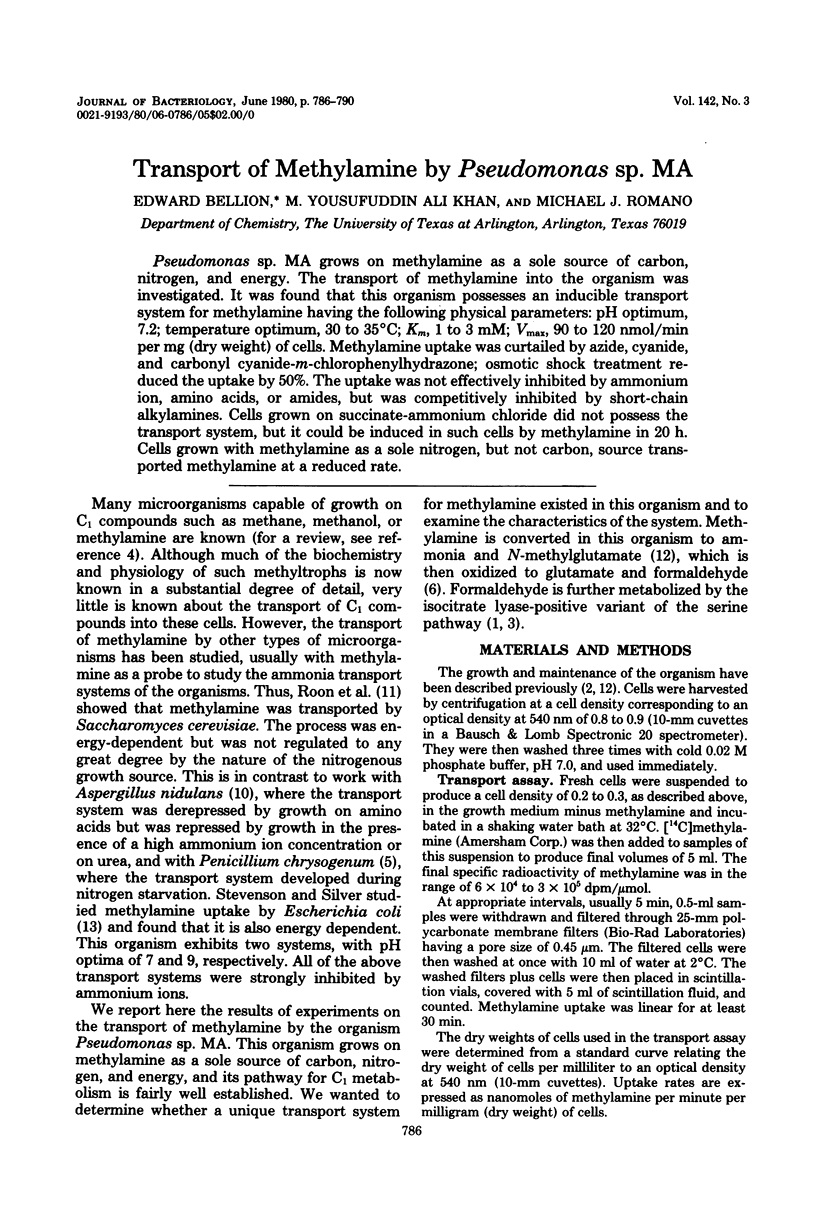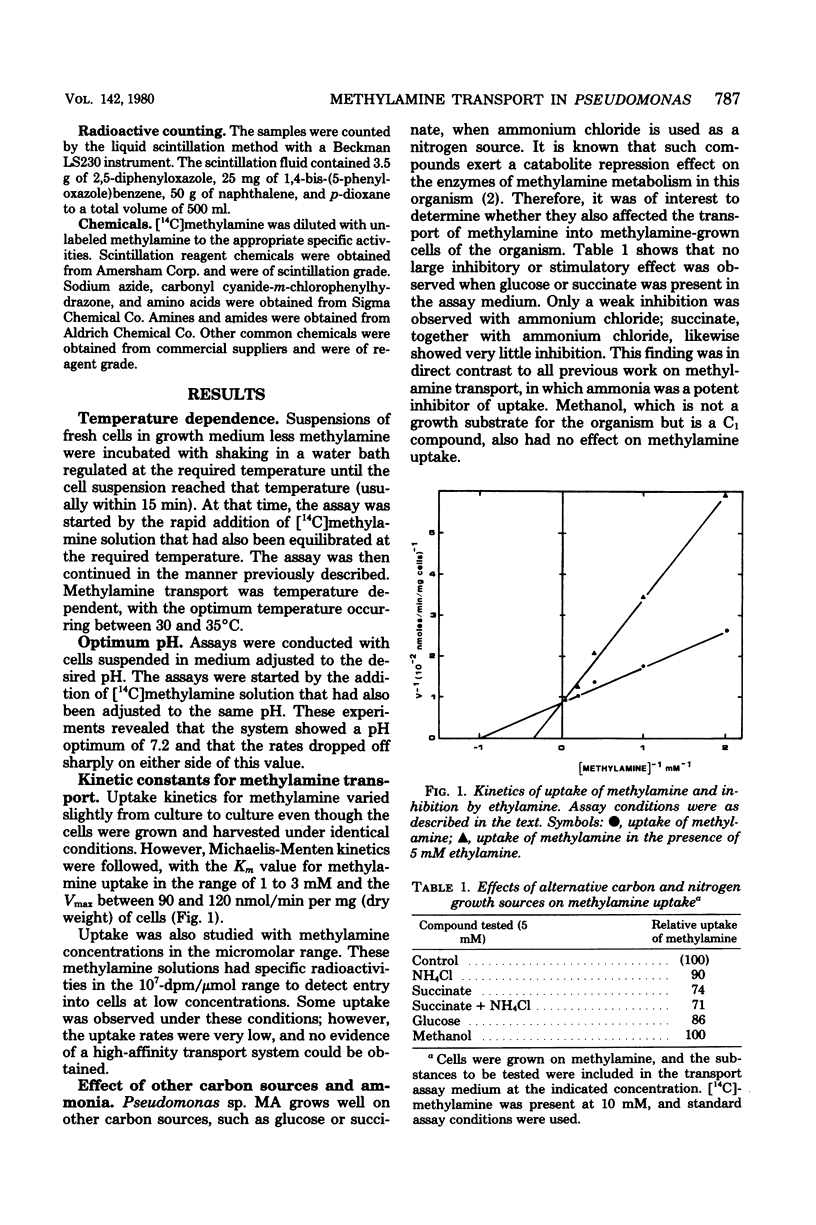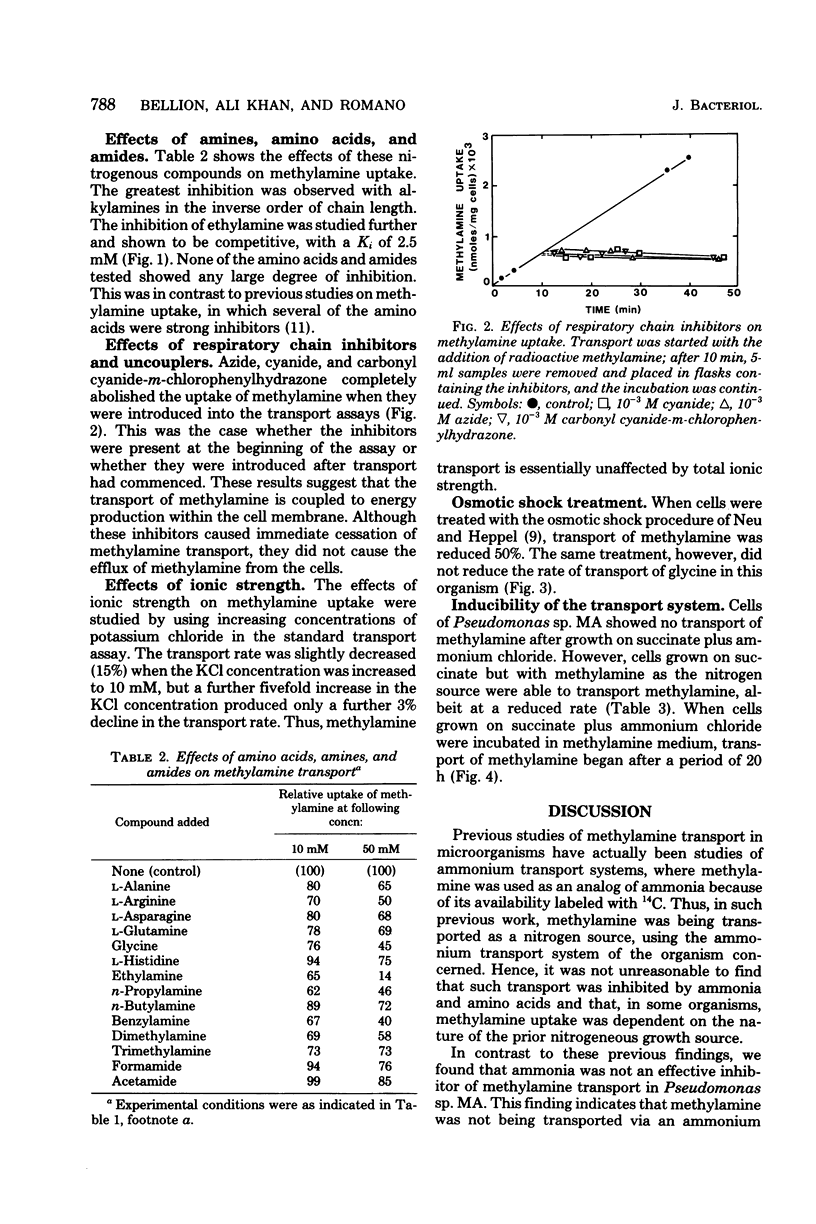Abstract
Pseudomonas sp. MA grows on methylamines as a sole source of carbon, nitrogen, and energy. The transport of methylamine into the organism was investigated. It was found that this organism possesses an inducible transport system for methylamine having the following physical parameters: pH optimum, 7.2; temperature optimum, 30 to 35 degrees C; Km, 1 to 30 mM; Vmax, 90 to 120 nmol/min per mg (dry weight) of cells. Methylamine uptake was curtailed by azide, cyanide, and carbonyl cyanide-m-chlorophenylhydrazone; osmotic shock treatment reduced the uptake by 50%. The uptake was not effectively inhibited by ammonium ion, amino acids, or amides, but was competitively inhibited by short-chain alkylamines. Cells grown on succinate-ammonium chloride did not possess the transport system, but it could be induced in such cells by methylamine in 20 h. Cells grown with methylamine as a sole nitrogen, but not carbon, source transported methylamine at a reduced rate.
Full text
PDF




Selected References
These references are in PubMed. This may not be the complete list of references from this article.
- Bellion E., Hersh L. B. Methylamine metabolism in a pseudomonas species. Arch Biochem Biophys. 1972 Nov;153(1):368–374. doi: 10.1016/0003-9861(72)90457-2. [DOI] [PubMed] [Google Scholar]
- Bellion E., Kim Y. S. Catabolite repression of isocitrate lyase in methylamine-grown Pseudomonas MA. Effect of carbon and nitrogen sources. Biochim Biophys Acta. 1978 Jul 17;541(4):425–434. doi: 10.1016/0304-4165(78)90152-6. [DOI] [PubMed] [Google Scholar]
- Bellion E., Woodson J. Two distinct isocitrate lyases from a pseudomonas species. J Bacteriol. 1975 May;122(2):557–564. doi: 10.1128/jb.122.2.557-564.1975. [DOI] [PMC free article] [PubMed] [Google Scholar]
- Colby J., Dalton H., Whittenbury R. Biological and biochemical aspects of microbial growth on C1 compounds. Annu Rev Microbiol. 1979;33:481–517. doi: 10.1146/annurev.mi.33.100179.002405. [DOI] [PubMed] [Google Scholar]
- Hackette S. L., Skye G. E., Burton C., Segel I. H. Characterization of an ammonium transport system in filamentous fungi with methylammonium-14C as the substrate. J Biol Chem. 1970 Sep 10;245(17):4241–4250. [PubMed] [Google Scholar]
- Hersh L. B., Peterson J. A., Thompson A. A. An N-methyl glutamate dehydrogenase from Pseudomonas M.A. Arch Biochem Biophys. 1971 Jul;145(1):115–120. doi: 10.1016/0003-9861(71)90016-6. [DOI] [PubMed] [Google Scholar]
- Hersh L. B., Tsai L., Stadtman E. R. The enzymatic synthesis of 5-hydroxy-N-methylpyroglutamic acid. J Biol Chem. 1969 Sep 10;244(17):4677–4683. [PubMed] [Google Scholar]
- Kung H. F., Wagner C. Gamma-glutamylmethylamide. A new intermediate in the metabolism of methylamine. J Biol Chem. 1969 Aug 10;244(15):4136–4140. [PubMed] [Google Scholar]
- Neu H. C., Heppel L. A. The release of enzymes from Escherichia coli by osmotic shock and during the formation of spheroplasts. J Biol Chem. 1965 Sep;240(9):3685–3692. [PubMed] [Google Scholar]
- Pateman J. A., Dunn E., Kinghorn J. R., Forbes E. C. The transport of ammonium and methylammonium in wild type and mutant cells of Aspergillus nidulans. Mol Gen Genet. 1974;133(3):225–236. doi: 10.1007/BF00267672. [DOI] [PubMed] [Google Scholar]
- Roon R. J., Even H. L., Dunlop P., Larimore F. L. Methylamine and ammonia transport in Saccharomyces cerevisiae. J Bacteriol. 1975 May;122(2):502–509. doi: 10.1128/jb.122.2.502-509.1975. [DOI] [PMC free article] [PubMed] [Google Scholar]
- Shaw W. V., Tsai L., Stadtman E. R. The enzymatic synthesis of N-methylglutamic acid. J Biol Chem. 1966 Feb 25;241(4):935–945. [PubMed] [Google Scholar]
- Stevenson R., Silver S. Methylammonium uptake by Escherichia coli: evidence for a bacterial NH4+ transport system. Biochem Biophys Res Commun. 1977 Apr 25;75(4):1133–1139. doi: 10.1016/0006-291x(77)91501-7. [DOI] [PubMed] [Google Scholar]


